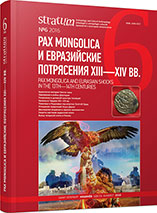Археология империи Чингис-хана в Монголии и Забайкалье
Archaeology of Genghis Khan Empire in Mongolia and Transbaikalia
Author(s): Nikolay Nikolaevich Kradin, Artur V. Kharinsky, Svetlana E. Baksheeva, Evgeny V. Kovychev, Stanislav D. ProkopetsSubject(s): History, Archaeology, Middle Ages, 13th to 14th Centuries
Published by: Издательский дом Stratum, Университет «Высшая антропологическая школа»
Keywords: Mongol Empire; Mongols; Genghis Khan; nomadic empires; nomadic urbanization; Eurasian archaeology
Summary/Abstract: The Mongol Empire was the biggest polity in pre-industrial Eurasia. It connected the West and the East by different communication networks. The deeds of the Mongols are well-known from written accounts, and there are numerous books and articles written on this subject. At the same time, the archaeological evidence dating to the earliest development of the Mongol Empire is much less known. This article summarizes the most recently available data on the main archaeological sites dated by the time before Genghis Khan and by the development of his empire. The authors examine the features of the funerary rite practiced by the early Mongols and the changes in it during the empire. They summarize the most recent findings from Karakorum — the capital of the Mongol Empire, as well as information about other towns of the early empire. The most recent results of archaeological investigations from hillforts and necropolises are introduced for discussion.
Journal: Stratum plus. Археология и культурная антропология
- Issue Year: 2016
- Issue No: 6
- Page Range: 17-43
- Page Count: 27
- Language: Russian
- Content File-PDF

